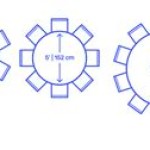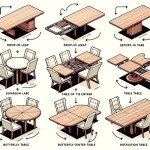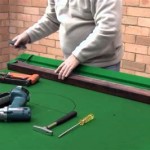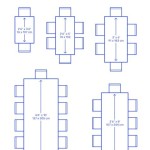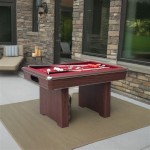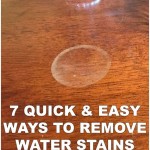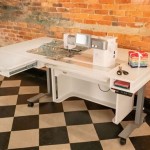Pads For Table Legs: Protecting Floors and Enhancing Stability
Pads for table legs are small, often overlooked, but vital components that play a significant role in protecting flooring surfaces and improving the stability of furniture. Available in a wide array of materials, shapes, and sizes, these pads act as a barrier between the hard legs of tables and the potentially damageable surfaces below. Understanding the purpose, types, and proper application of table leg pads can significantly extend the life of flooring, reduce noise, and prevent unwanted movement of furniture.
The primary function of table leg pads is to prevent scratches, dents, and other forms of damage to flooring materials. Hardwood, laminate, tile, and even vinyl flooring are all susceptible to damage from the constant friction and pressure exerted by table legs. Without protection, the movement of a table, whether intentional or accidental, can quickly lead to unsightly marks and costly repairs. Furthermore, these pads can reduce the noise generated when a table is moved, which is particularly beneficial in apartments or multi-story homes.
Beyond floor protection, table leg pads can also contribute to the stability of a table. Uneven floors are a common problem in many homes, and even slight variations in floor height can cause a table to wobble. By strategically placing pads beneath the legs, it is possible to compensate for these irregularities and create a more stable and level surface. This is especially important for dining tables, work desks, and other surfaces where stability is crucial.
Key Point 1: Material Types and Their Applications
The effectiveness of table leg pads largely depends on the material from which they are constructed. Each material offers unique properties that make it suitable for different flooring types and furniture weights. Selecting the appropriate material is crucial for optimal performance and longevity.
Felt pads are among the most common and versatile options. Made from compressed fibers, felt provides a soft and cushioning layer that effectively protects most flooring surfaces from scratches and scuffs. They are particularly well-suited for hardwood, laminate, and tile floors. Felt pads are relatively inexpensive and easy to install, typically featuring an adhesive backing that allows them to be quickly attached to table legs. However, felt pads can wear down over time, especially under heavy furniture or in high-traffic areas. Regular inspection and replacement are necessary to maintain their protective qualities.
Rubber pads offer superior grip and durability compared to felt. The rubber material provides a non-slip surface that prevents furniture from sliding or moving unintentionally. This makes them an excellent choice for use on tile, vinyl, and even carpeted surfaces. Rubber pads are also resistant to moisture and are less likely to harbor dirt and debris compared to felt. Due to their greater density, they typically offer better protection against dents and heavy impacts. Rubber pads are available in a variety of thicknesses and sizes, allowing for customization based on the weight and type of furniture.
Plastic pads are another option, often made from polyethylene or other durable polymers. These pads offer a balance between protection and glide. They are particularly useful for furniture that needs to be moved frequently, as they allow the table to slide smoothly across the floor without causing damage. Plastic pads are also resistant to moisture and chemicals, making them suitable for use in kitchens and dining areas where spills are common. However, plastic pads may not provide as much cushioning as felt or rubber, and they can sometimes be prone to scratching softer flooring materials.
Cork pads are a natural and eco-friendly alternative. Cork is a resilient material that offers good cushioning and grip. It is also naturally resistant to mold and mildew, making it a good choice for humid environments. Cork pads are often used on hardwood and tile floors, providing a sustainable and effective barrier against scratches and dents. The natural texture of cork also adds a subtle aesthetic appeal. However, cork pads may be more susceptible to wear and tear compared to rubber or plastic, and they may require more frequent replacement.
Metal pads, typically incorporating a metal disc or plate, are designed for extremely heavy furniture or for situations where added durability is required. These pads often feature a non-scratching base material, such as felt or rubber, attached to the metal component. The metal provides additional support and prevents the pad from compressing or deforming under significant weight. Metal pads are commonly used on industrial furniture or in commercial settings where furniture is subjected to heavy use.
Key Point 2: Installation Methods and Considerations
Proper installation is crucial for ensuring that table leg pads function effectively and provide the intended level of protection. Incorrect installation can lead to premature wear, reduced effectiveness, and even damage to the pads or the flooring. Factors to consider include the type of pad, the surface of the table leg, and the type of flooring.
Adhesive-backed pads are the most common and easiest to install. These pads feature a peel-and-stick adhesive that allows them to be quickly attached to the bottom of table legs. Before application, it is essential to clean the surface of the table leg thoroughly to remove any dirt, dust, or debris. This ensures a strong and lasting bond. The pad should be centered on the leg and pressed firmly into place. For optimal adhesion, it is recommended to allow the adhesive to cure for several hours before placing the table on the floor.
Screw-in pads offer a more secure and permanent attachment. These pads feature a threaded stem that screws directly into the table leg. Screw-in pads are particularly well-suited for heavier furniture or for situations where adhesive pads may not provide sufficient hold. Installation requires drilling a pilot hole into the table leg and then screwing the pad into place. It is important to select the correct screw size and to avoid over-tightening, which could damage the table leg. Screw-in pads are often adjustable, allowing for fine-tuning of the table's height to compensate for uneven floors.
Nail-on pads provide another option for secure attachment. These pads feature small nails that are hammered into the table leg. Nail-on pads are commonly used on wooden furniture, providing a strong and reliable bond. Installation requires careful hammering to avoid splitting the wood. It is important to use small, fine nails to minimize the risk of damage. Nail-on pads are generally less adjustable than screw-in pads, but they offer a more traditional and aesthetically pleasing appearance.
Slip-on pads, also known as leg caps or sleeves, are designed to slide over the entire table leg. These pads are typically made from rubber or plastic and provide a snug and secure fit. Slip-on pads are particularly useful for protecting the entire lower portion of the table leg from scratches and scuffs. They are also easy to install and remove, making them a convenient option for temporary or rental situations. However, slip-on pads may not be suitable for all table leg shapes and sizes, and it is important to select the correct size to ensure a secure fit.
Regardless of the installation method, it is crucial to select pads that are the correct size and shape for the table legs. Pads that are too small may not provide adequate protection, while pads that are too large can be unsightly and may interfere with the table's stability. It is also important to consider the thickness of the pads. Thicker pads provide greater cushioning and protection, but they may also raise the height of the table, which could affect its overall appearance and functionality.
Key Point 3: Maintenance and Longevity
To ensure that table leg pads continue to function effectively over time, regular maintenance and inspection are essential. Factors such as wear and tear, dirt accumulation, and environmental conditions can all affect the longevity and performance of the pads. Implementing a simple maintenance routine can significantly extend the life of the pads and protect flooring surfaces.
Regular cleaning is crucial for preventing the accumulation of dirt and debris on table leg pads. Dirt particles can act as an abrasive, scratching the flooring surface even when pads are in place. Use a soft cloth or brush to gently remove any dirt or dust from the pads. For stubborn stains, a mild detergent solution can be used. It is important to avoid using harsh chemicals or abrasive cleaners, as these can damage the pad material.
Periodic inspection of the pads is necessary to identify any signs of wear and tear. Check for worn spots, tears, or detachment from the table legs. Felt pads, in particular, are prone to wearing down over time, especially in high-traffic areas. Rubber and plastic pads may become brittle or cracked with age. If any damage is detected, the pads should be replaced immediately to prevent further damage to the flooring.
The type of flooring and the amount of use the table receives can significantly impact the lifespan of the pads. Tables located in high-traffic areas or on abrasive flooring surfaces will require more frequent pad replacement. Consider using more durable materials, such as rubber or metal, for tables that are subjected to heavy use. In addition, using larger pads can help distribute the weight of the table more evenly, reducing the strain on individual pads.
Environmental factors can also affect the longevity of table leg pads. Exposure to excessive moisture, heat, or sunlight can cause certain materials to degrade prematurely. Avoid placing tables with pads in areas that are prone to moisture or direct sunlight. In humid environments, consider using pads made from moisture-resistant materials, such as rubber or plastic. Regular ventilation can also help prevent the growth of mold and mildew on the pads.
When replacing table leg pads, it is important to remove any residue from the old pads before installing the new ones. Use a scraper or adhesive remover to clean the surface of the table legs thoroughly. This will ensure a strong and lasting bond between the new pads and the legs. It is also a good idea to replace all of the pads at the same time, even if only some of them are worn. This will ensure that the table remains level and stable.

Furniture Chair Leg Pad Table Legs Non Slip Silent Rubber Feet Cushion Floor

Cozyrooms Diy Furniture Chair Leg Pad Table Legs Non Slip Silent Rubber Feet Cushion Floor Protection Round Square Lazada Ph

Furniture Pads Adhesive Rubber Diy Feet Pad Table Temu United Kingdom

Looy Self Adhesive Scratch Rubber Furniture Protection Pads Kit Table Legs In Buy At Flipkart Com

3sets 5sets Table Legs Pads Anti Scratch Floor Protectors Slip Rubber Chair Feet Mute Stickers Leg Furniture Accessories Fruugo No

Square Eva Foam Furniture Pad Table Leg Heightening Temu

Table Legs Pads Anti Scratch Floor Protectors Slip Rubber Chair Feet Mute Stickers Leg Furniture Accessories Fruugo No

Furniture Pads Best Felt Floor Protectors Pad Premium Chair Leg Felts Feet 2 4 12 30 48 Rubber Bumpers Com

12pcs Chair Leg Pads Table Sofa Desk Corner Anti Slip Mat Stool Quiet Wear Resistant Protective Cover For Legs And Feet Shein
16pcs Silicone Chair Leg Caps Feet Pads Furniture Table Covers Floor Protector Com
Related Posts

